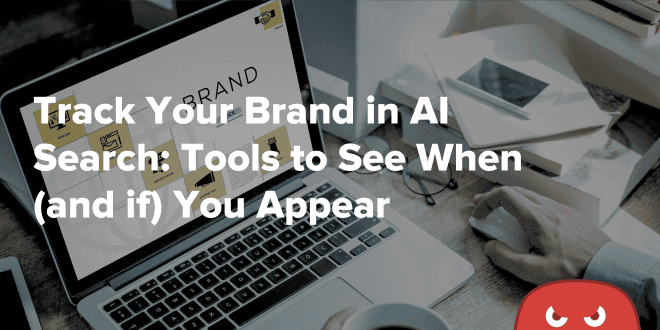
Track Your Brand in AI Search: Tools to See When (and if) You Appear
- 60% of Google searches ended in zero clicks in 2024
- 71% of people now use AI platforms like ChatGPT to search the web
- Google’s LLM-powered AI Overviews now appear for almost all queries (pushing organic results further down the page)
Why Tracking AI Visibility Matters
Search visibility is rapidly taking on a new form. While classic search engines like Google and Bing aren’t going anywhere anytime soon (after all, AI tools rely on their indexes), the way users search for information online is transforming. Let’s take Google as an example. Before AI Overviews, users would almost always click on an organic result (the ‘blue links’) to find the information they needed: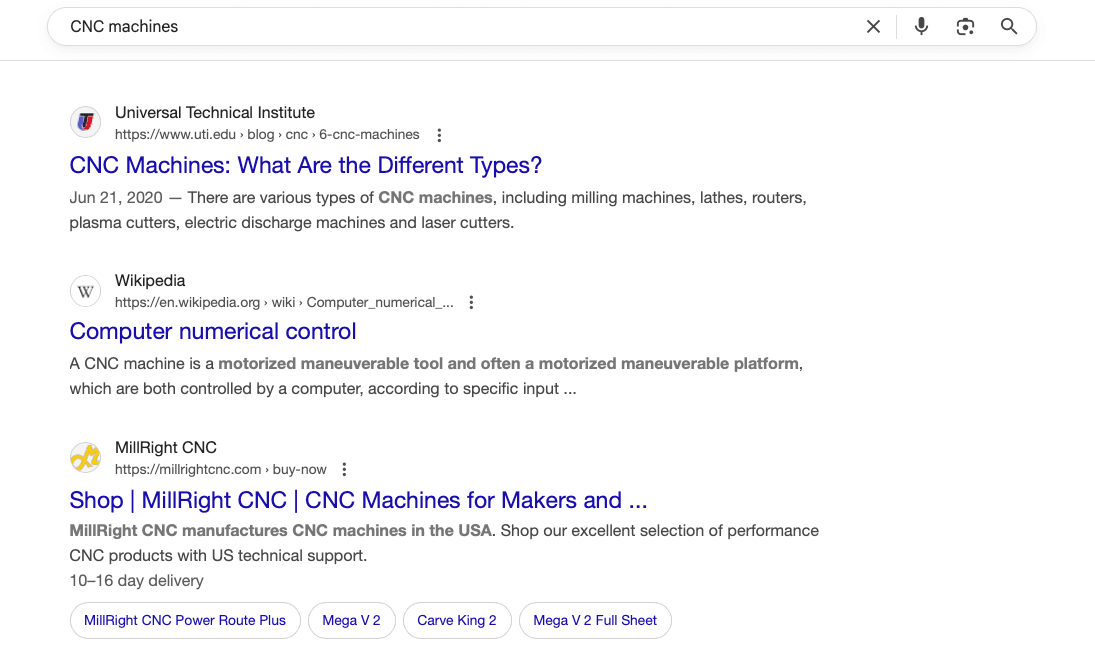 This presented a great opportunity for brands to generate traffic to their websites through helpful content (and still does, but things are undoubtedly changing).
Featured snippets (quick definitions and answers that appeared at the top of the page) would occasionally result in zero-click searches, but even they featured one standalone result for users to click on:
This presented a great opportunity for brands to generate traffic to their websites through helpful content (and still does, but things are undoubtedly changing).
Featured snippets (quick definitions and answers that appeared at the top of the page) would occasionally result in zero-click searches, but even they featured one standalone result for users to click on:
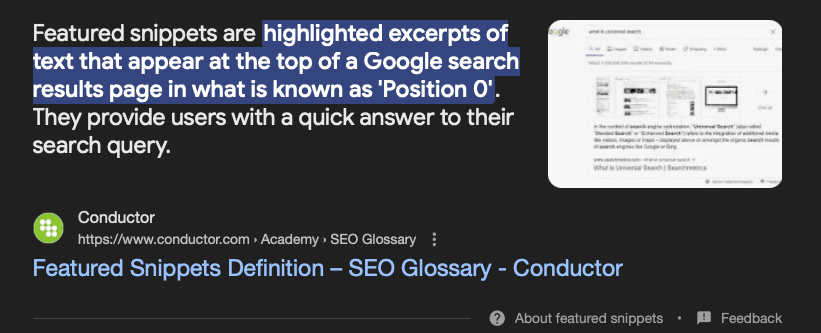 Now, virtually every query on Google generates a lengthy AI Overview that dominates the top of the search results page:
Now, virtually every query on Google generates a lengthy AI Overview that dominates the top of the search results page:
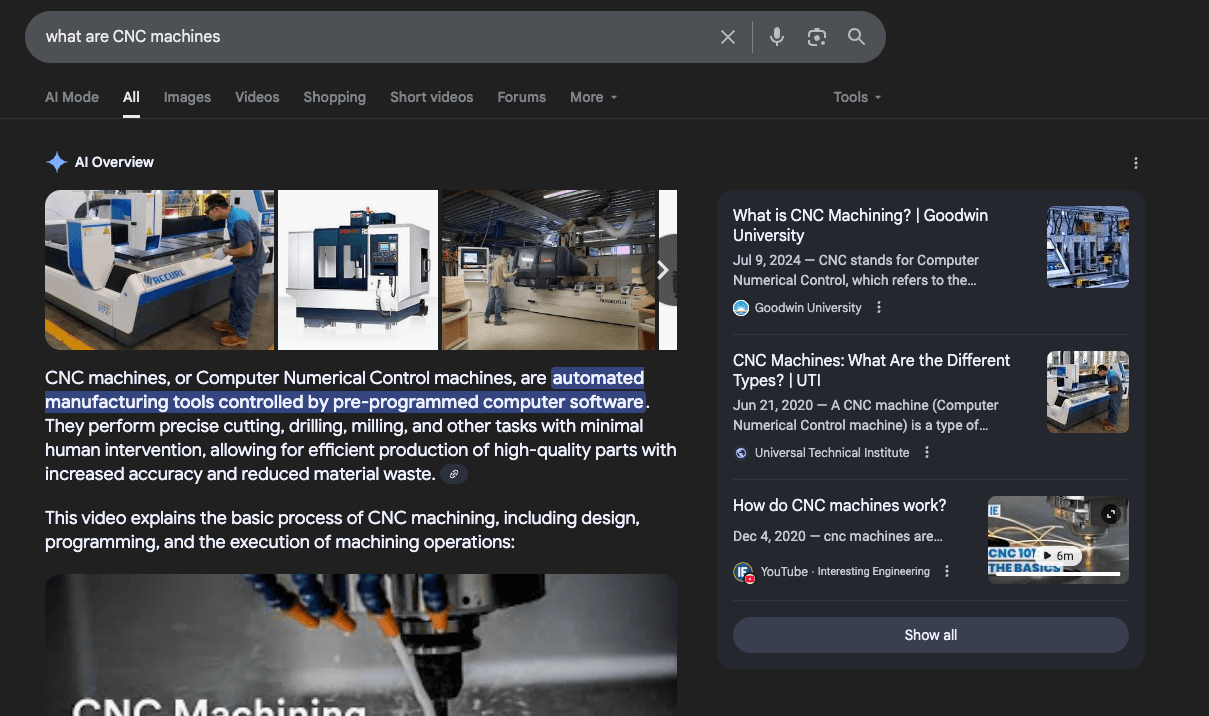 As you can see, users must scroll down to see the organic search results (besides the three sources listed as citations).
The result?
Websites are receiving far fewer clicks for keywords that generate AI Overviews.
Research by Ahrefs uncovered that, when present, AI Overviews reduce clicks by 34.5%.
Also, traffic to news publishers plummeted from 2.3 billion visits to 1.7 billion visits within just one year (Similarweb) because of AI and zero-click search behavior.
As you can see, users must scroll down to see the organic search results (besides the three sources listed as citations).
The result?
Websites are receiving far fewer clicks for keywords that generate AI Overviews.
Research by Ahrefs uncovered that, when present, AI Overviews reduce clicks by 34.5%.
Also, traffic to news publishers plummeted from 2.3 billion visits to 1.7 billion visits within just one year (Similarweb) because of AI and zero-click search behavior.
Clicks are no longer sufficient
Since clicks are dropping so rapidly, does that mean this is the beginning of the SEO Armageddon? Actually, no! Research has also found that while clicks are down, other metrics, like direct brand searches, are up, assuming that you have decent AI search visibility. For example, Samsung was able to attribute 28% of its direct brand searches to increased zero-click exposure. In other words, their brand still benefited from being cited in AI Overviews and AI-generated summaries, just not through immediate clicks. Better.com also discovered its brand recall had improved by 41% after optimizing its content for AI search. What brands are starting to uncover is:- Visibility in AI search drives downstream engagement (delayed clicks, direct brand searches, etc.).
- Appearing in AI Overviews builds trust with users and spreads brand awareness.
- Fewer clicks don’t equal less value.
 Now, it’s crucial for websites to use AI visibility tools to track a brand-new set of metrics.
Let’s look at how you can do just that.
Now, it’s crucial for websites to use AI visibility tools to track a brand-new set of metrics.
Let’s look at how you can do just that.
Monitor Brand Mentions in AI Tools
One of the most important trust signals to LLMs is the number and quality of brand mentions you have online. If trusted publications mention your brand in a positive light, LLMs will begin to view you as an authority figure and will become more likely to cite your content and recommend your brand. Therefore, earning quality brand mentions is paramount for improving AI SEO. Yet, once you start engaging in digital PR campaigns and other tactics, you’ll need a way to measure your success. To do so, you can use dedicated media monitoring tools like: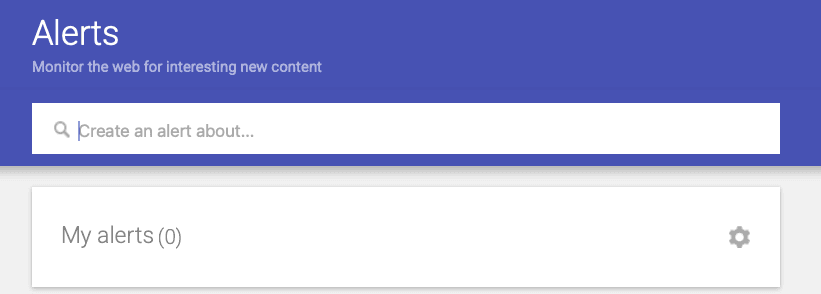 Don’t forget to customize the alert to your preferences, like whether you receive it once a day or once a week:
Don’t forget to customize the alert to your preferences, like whether you receive it once a day or once a week:
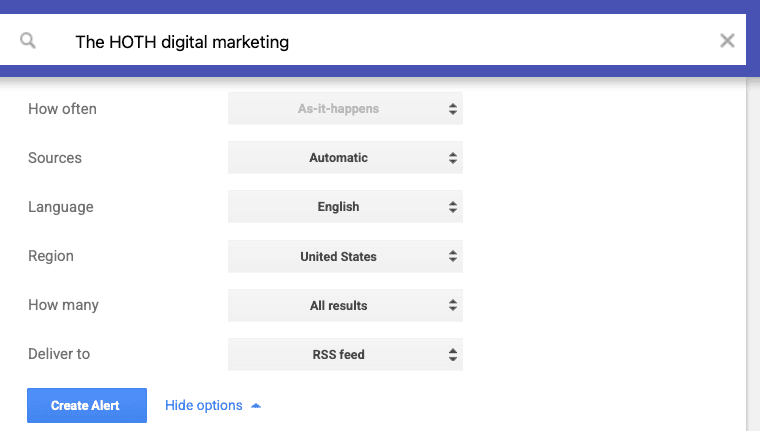 You can also receive alerts every time a new mention goes live by selecting the ‘as it happens’ option.
To ensure your alerts are set up for your brand (and not similarly named brands or concepts), check the Alert Preview section:
You can also receive alerts every time a new mention goes live by selecting the ‘as it happens’ option.
To ensure your alerts are set up for your brand (and not similarly named brands or concepts), check the Alert Preview section:
 As long as the preview mentions your brand and not someone or something else, you’re all set!
As long as the preview mentions your brand and not someone or something else, you’re all set!
| Need more high-quality brand mentions and backlinks? Our Digital PR service has your back! |
Use BrightEdge and Similar Platforms
Out of all the emerging AI search tools, BrightEdge’s AI Catalyst is one of the few that actually offers structured data on AI mentions. Here’s a screenshot from their official website: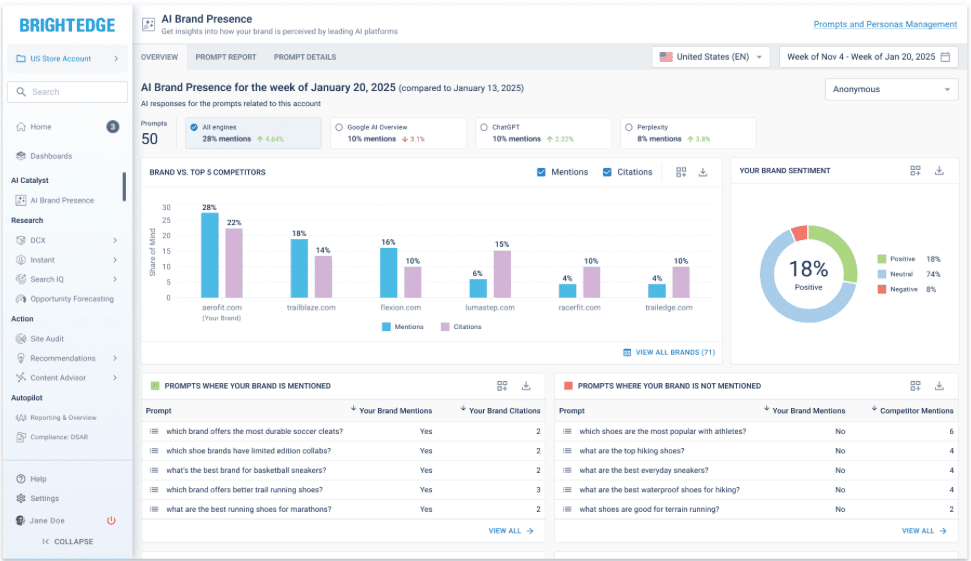 With this tool, you can directly monitor your brand mentions across all major AI search platforms from a single dashboard.
You can also view your brand sentiment, prompts where you’re cited, and prompts where your brand isn’t mentioned yet.
Besides BrightEdge, you can also use Ahrefs and Semrush to reverse engineer traditional SEO metrics.
For instance, look up the pages that rank highest for informational queries in your field (question-based, how-to, and definition-type keywords).
Why should you do this?
You should because the chances are these are the pages that are getting summarized most by AI search tools.
High search rankings for these types of queries typically mean the domains have built lots of topical authority, which matters a lot to LLMs.
This can give you an idea of what type of content you should mimic to improve your visibility on AI tools (and traditional search rankings).
With this tool, you can directly monitor your brand mentions across all major AI search platforms from a single dashboard.
You can also view your brand sentiment, prompts where you’re cited, and prompts where your brand isn’t mentioned yet.
Besides BrightEdge, you can also use Ahrefs and Semrush to reverse engineer traditional SEO metrics.
For instance, look up the pages that rank highest for informational queries in your field (question-based, how-to, and definition-type keywords).
Why should you do this?
You should because the chances are these are the pages that are getting summarized most by AI search tools.
High search rankings for these types of queries typically mean the domains have built lots of topical authority, which matters a lot to LLMs.
This can give you an idea of what type of content you should mimic to improve your visibility on AI tools (and traditional search rankings).
Benchmark Prompt Responses with Competitors
Next, you should manually test popular prompts in your niche. Not only will this let you know if your brand is getting mentioned or not, but it’ll help you create a competitor benchmark. In other words, you’ll get to see all the prompts that your competitors are getting cited for, but you aren’t. As an example, here’s a prompt you should look up if you provide CNC machines: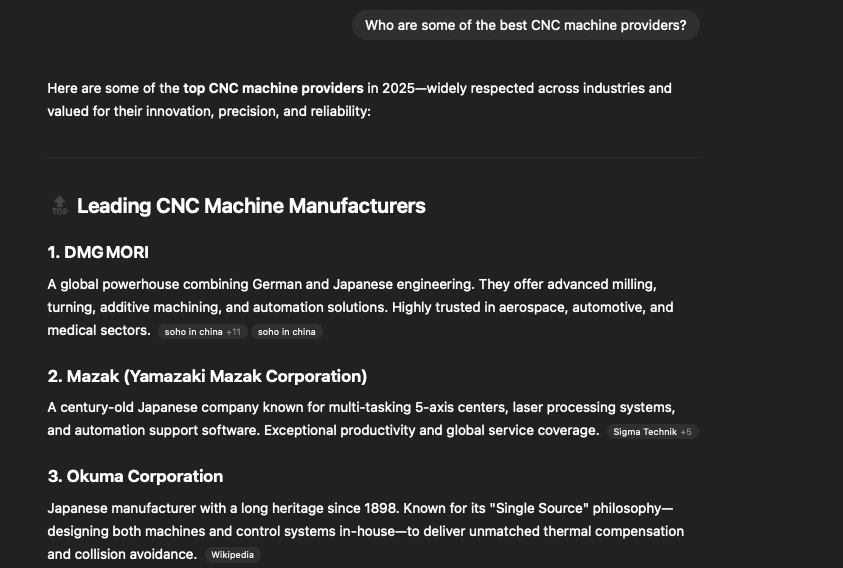 Having a benchmark like this makes goal setting extremely easy.
All you have to do is make a list of the prompts that you want to get cited for the most (but aren’t currently).
You’ll also discover who your top AI search competitors are, who may not necessarily be the same as your competitors on Google.
Having a benchmark like this makes goal setting extremely easy.
All you have to do is make a list of the prompts that you want to get cited for the most (but aren’t currently).
You’ll also discover who your top AI search competitors are, who may not necessarily be the same as your competitors on Google.
Document Citations in AI Overviews
Lastly, you should actively document your citations in AI Overviews. Even if you have access to a tool like BrightEdge, it’s still a good idea to do your own homework and track your citations manually. After all, no tool’s data is 100% accurate, so you may discover some intriguing discrepancies. You don’t need a fancy tool to do this, either, as you can keep everything in an Excel spreadsheet. Be sure to include:- The prompt
- The cited URLs
- Whether your domain is cited or not
- The content format most cited in AI responses (like blogs, listicles, FAQs, etc.)
Concluding Thoughts: The Need for AI Visibility Tracking Tools
Clicks and search rankings are no longer sufficient for measuring your success with search marketing. To keep up with the rapidly changing search landscape, you need to track your brand’s visibility on AI search tools like ChatGPT, Perplexity, and Claude. Do you need help developing an SEO strategy that includes AI? Don’t wait to book a free strategy call with us to find the perfect solution!The author
Rachel Hernandez
description
Previous
Prompt-Aligned SEO: Writing Content That AI Wants to Summarize
Next
How Links Power the AI SEO Funnel
Discussion
Comments
Digital Marketing Academy in Kerala
October 28th, 2025
great work
Anju
October 7th, 2025
Thanks for sharing the informative article.
Shuhaib Kp
September 18th, 2025
nice good articles
